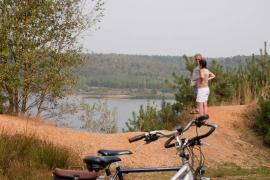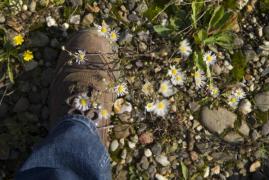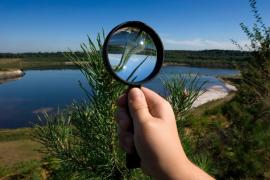The National Park is a large and diverse area. A home for more than 9000 species of plants and animals. And yet, many could use a boost.
Cutting trees for a better forest
Don't be alarmed if you see trees being felled. Many of the forests in the National Park were created for, among other things, the mining industry. They are actually monotonous plantations, not very interesting for nature. Through targeted felling, these forests are becoming more varied, so that, for example, more birds come to nest.
In addition, some species, such as American bird cress and American oak, are a real plague for the Hoge Kempen. By cutting these exotics, native trees are favoured. The presence of pedunculate oak, rowan and birch also brings additional plant and animal species back into the forest.
The forest roads often suffer during the felling works, especially in wetter periods. Not pleasant for hikers, but this damage is always repaired after the works.
Dead wood brings life
Trees are not given eternal life either. Sooner or later, every tree dies. Yet a dead tree is invaluable to the forest. Numerous animals find their home, breeding place and food there. Mushrooms, too, are usually found on dead wood. The manager leaves fallen branches or dead trees where they belong: in the forest.
Counting sheep?
Don't be surprised if during a walk on the Mechelse Heide you see a flock of sheep grazing. The shepherd and his dog are nearby. Sheep move around and eat places that are bare. New heather and other plants grow there. Otherwise you get a lot of trees and high grass, which is not very interesting for many species. The sheep have plenty of food, even in winter.
Fire?!
Controlled burning of heather is a useful technique for preventing beetle infestations and rejuvenating heather. Early spring is the best period. A slow fire allows animals to escape and species to live in the wet soil. Fire is a natural process in nature and makes a lot of new life possible. A controlled fire never lasts longer than 3 hours and the fire brigade is also present.
Please note that heathland and forests are very sensitive to fire and an uncontrolled fire can cause a lot of damage. Extra caution is needed in dry periods.
Other management works to rejuvenate the heathland take place mainly in winter, such as mowing, chopping or plowing. In order to prevent the heathland from becoming overgrown, spontaneous tree cuttings should be cut back regularly.
Big grazers!
In order to increase the variety of the landscape and thus the number of plant and animal species in the National Park, the managers let themselves be helped by Norwegian fjord horses, Konik horses, Angus cattle and even donkeys. They are self-sufficient breeds that can live in the area all year round without much help. They look dangerous, but if you stick to a few rules, you have nothing to fear: do not challenge the animals, keep your distance and do not feed them. Dogs are not allowed on walks in grazing areas.
Wildlife management
The basic principles of hunting are the management of game populations and the prevention of damage. In the National Park, this management hunting is mainly focused on the wild boar and the roe deer. Hunting is subject to strict conditions, e.g. in large areas hunting is not allowed or only for a short period of time.




